Japan is world-renowned as a paradise for food lovers. The only trouble is knowing what to try, the best places to go, and where to start. Get ready for Japanese Street Food Explained.
Table of contents:
Intro
A Brief History of Street Food in Japan
Top 12 Japanese Street Foods
Where To Find Japan’s Best Street Food
Bonus Tips To Get The Most Out of Your Japanese Foodie Holiday
Intro
Street Food is hugely popular all around the world. From London to Los Angeles, Mexico to Madrid, eating from stalls and vendors has transformed its image during the early 21st Century to become one of the coolest ways to enjoy a meal. Japan is no different and its street food vendors are known as Yatai. The country is well known for being one of the global capitals for food lovers and while street food stalls were once on the decline, the concept is officially making a comeback in Japan – which is simply and indisputably one of the best places in the world to eat. Of course, the sheer variety and volume of amazing dishes can seem daunting, especially if you’re new to Japanese cuisine, and that’s where we come in. We’ll tell you where to go, what dishes to try, and how to get there with the JR Pass for unlimited travel on Japan’s excellent and ever-reliable domestic rail network. Get ready for Japanese Street Food Explained.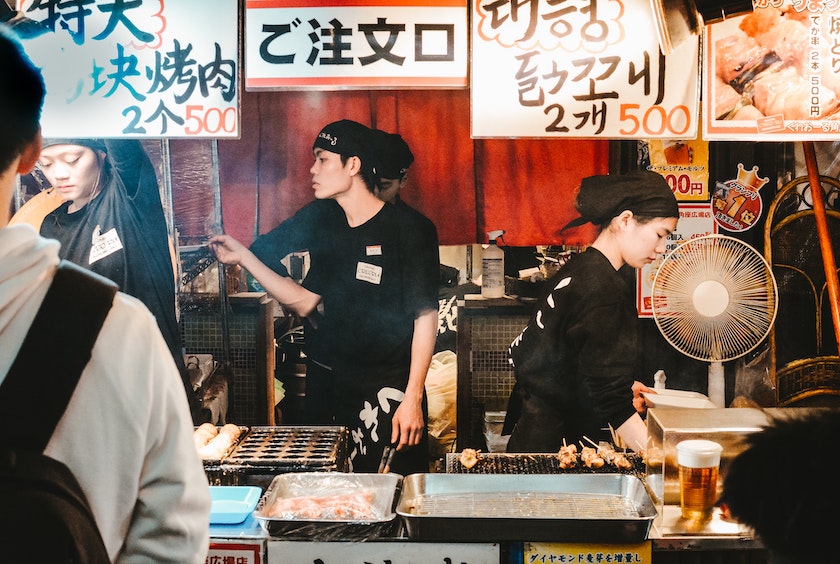
A Brief History of Street Food in Japan
There is an interesting backstory to Japanese Street Food. In fact, depending on who you ask, street food doesn’t exist in Japan – at least, not in the same way that people think about street food in Mexico, London, or even in other Asian countries such as Thailand and Taiwan. Japan definitely has street food, but there is simply a different culture (and a different history) surrounding it. For instance, street food is less associated with nightlife in Japan and is more closely linked to festivals (matsuri) and events.
As we mentioned in our intro, street food vendors are known as Yatai in Japan and while they can be seen in abundance at festivals, they are a less common everyday sight in streets or alleyways. There are some exceptions however such as the Nakasu district of Fukuoka and other areas known for all-year-round street food. However, even in these hotspots they were becoming less common. The reason? There are a few different theories all around a similar theme – because Yatai were seen as part of night culture, they were frowned upon as the Japanese government worked to change its image after the war and become more of an upmarket tourist destination. Laws were passed that made opening and running Yatai difficult and they gradually became less and less. And in contrast to elsewhere in the world, Yatai were seen less as hip places to try authentic and daring food and more as places for late-night eating and drinking.
However, attitudes have changed regarding street food, not just in Japan, but worldwide, as leading chefs began experimenting with street food and the concept was embraced by the global ‘hipster’ community. Today, it is generally accepted that after years of being less commonly found across Japan, Yatai have made a resurgence (especially since 2016 due to a relaxation of some of the aforementioned laws) and also in line with similar trends around the world, but in a uniquely Japanese way and with the country’s trademark incredible dishes.
Top 12 Japanese Street Foods
What makes Japanese street food so special? Is it the freshness? The quality of ingredients? The skill with which they are prepared? The variety? The incredible produce? The answer is it’s all of the above and more. Your favourite from the list below will depend on your own culinary preferences, but what’s for certain is there is a huge variety of street food to choose from in Japan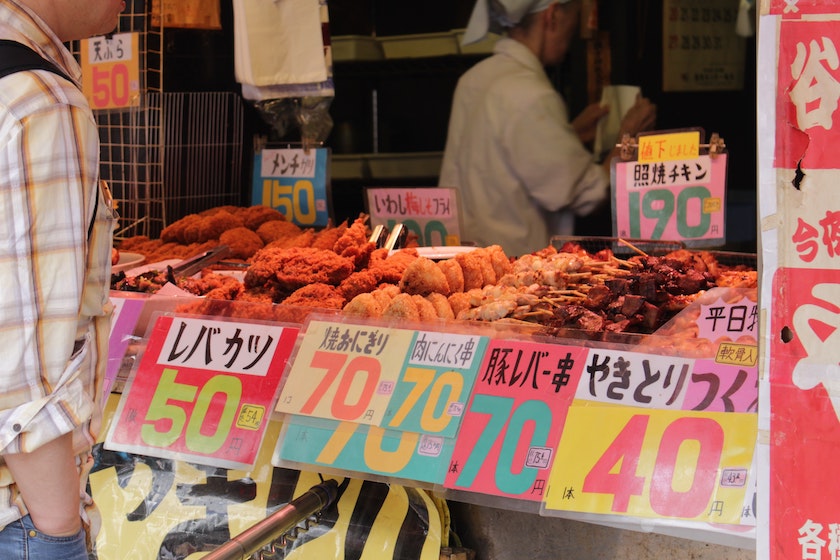
Okonomiyaki
A street food classic and a specialty of Osaka, Okonomiyaki is essentially a savoury pancake packed with cabbage, egg, seafood and noodles. However, you should definitely check out Hiroshima’s layered twist of this famous dish, which has an equally great reputation. Get to Hiroshima from Osaka using JR Pass by taking the Sakura bullet train on the Sanyo line.
Yakitori
Skewered meat grilled over charcoal – the beautiful simplicity and amazing taste of Yakitori makes it a street food favourite in Japan.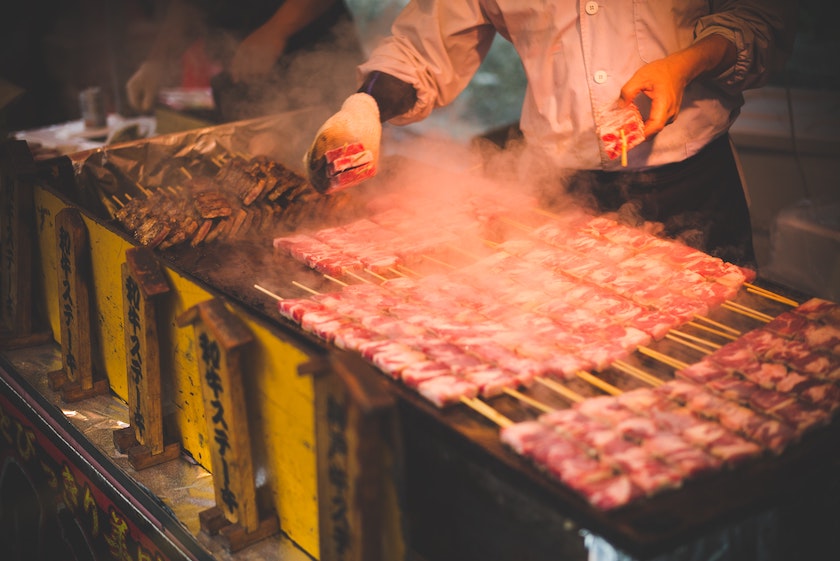
Yaki Imo
Sweet potatoes baked over a wood fire, Yaki Imo are sold by trucks and carts that traditionally drove around advertising their wares through a loudspeaker that repeated ‘Yaki Imo’ over and over. These trucks, fitted with wooden stoves that send clouds of smoke into the air, have long been seen as a nostalgic symbol of Japan’s street food past. You’ll also find Daigaku Imo, which sees deep-fried sweet potato served with sweet syrup and sesame seeds or sometimes cut into chips or crisps. Also look out for another street food favourite called Jaga Bata, which is basically a regular baked potato with its skin peeled off and covered with butter.
Imagawayaki
A thick pancake like dish filled with red bean paste, meat, potatoes, curry, cheese or custard, Imagawayaki can be found across Japan with different names and different fillings depending on the region.
Tomorokoshi
People are often surprised that corn cobs (which are often seen as being quintessentially American) are so popular in Japan, especially from Yatai street vendors and Matsuri stalls. Of course, the Japanese version is unique and delicious – it is grilled with miso, butter, and soy and served on a stick. Tomorokoshi is traditionally associated with the Hokkaido region.
Takoyaki
Diced octopus encased in a light batter and rolled into a ball with spring onion and ginger and topped with green seaweed, sauce, sliced and dried bonito, and sometimes drizzled with mayonnaise. This delicious dish is famously a speciality of Osaka – a city known as Japan’s kitchen. You can reach Osaka from Tokyo on the Hikari and Kodama trains on the Tokaido Shinkansen lines using the Japan Rail Pass.
Yakisoba
Egg noodles fried with mixed vegetables and served in gently sweet and savoury Yakisoba sauce, along with meat or vegetables – ideal for newcomers to Japanese cuisine.
Kare pan
Essentially a savoury donut, Kare pan is made of sweet fried dough and filled with Japanese curry. This can be an unusual, but surprisingly tasty snack if you’re expecting something sweet. Japanese curry is another hugely popular street food dish and can be found right across the country. Other sweet treats include Japanese crepes, which are very popular from Yatai vendors, Bebi Kasutera, a ‘baby’ sized sponge cake, Choco Banana (which is exactly what it sounds like!), Shaved Ice (a favourite in the hot summer months), and Taiyaki – fish-shaped cakes that are filled with either chocolate, custard and even cheese.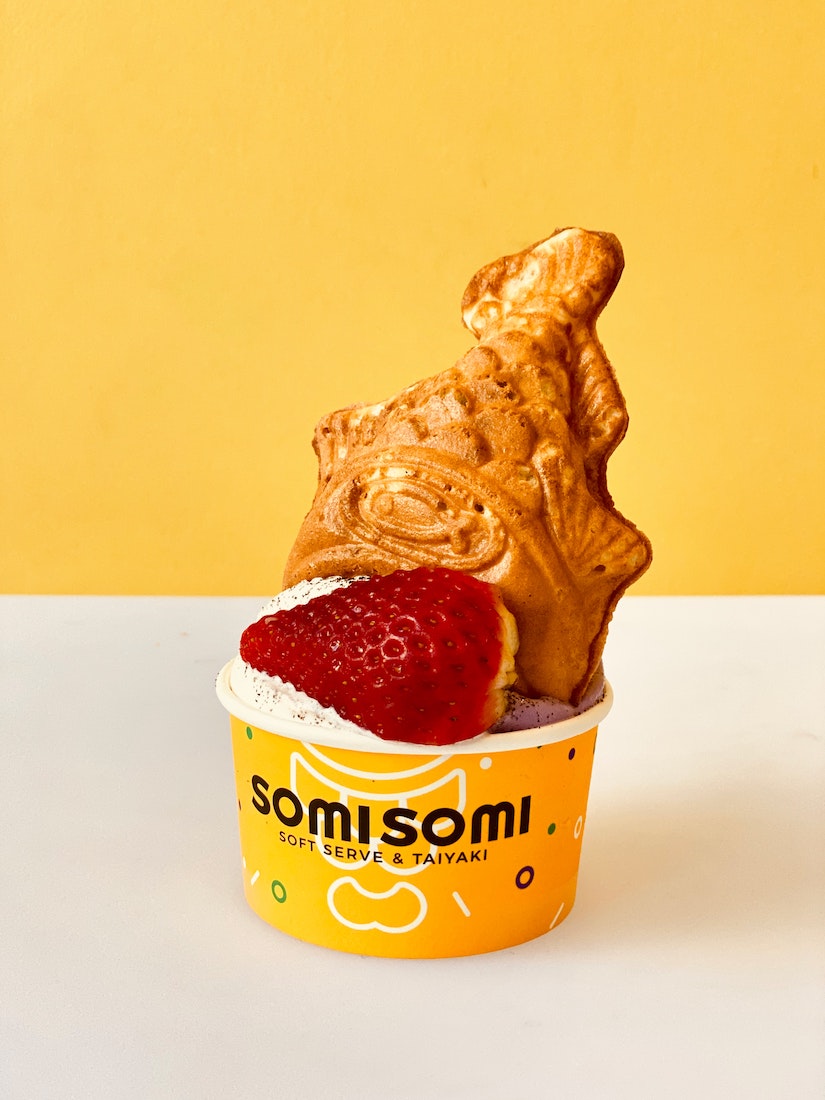
Korokke
The Japanese version of a French classic, the potato croquette, Japan’s Korokke is filled with meat, seafood or vegetables and rolled in wheat flour, eggs, then panko breadcrumbs before being deep-fried to a golden brown. Look out for regional variations with different fillings.
Shioyaki
This is a salty fish, often mackerel, that is baked and served on a stick. A variation of this dish called tai no shioyaki, made using salt-grilled sea bream, is a traditional food at New Year’s. Also look out for Ikayaki – grilled squid that is served in a similar way and which is another popular street food dish.
Senbei
Hugely popular and ubiquitous rice crackers that are available in hundreds of different flavours. There are many regional variations and the kind you will find at Yatai street food vendors are usually cooked over a charcoal grill.
Dango
Served on a skewer, these round dumplings are made from rice flour and water and boiled until firm. They come in many varieties, including sweet and savoury, and they are very popular at food stalls at festivals. You will often find them outside Shinto shrines, and they are also a favourite snack at Hanami (flower gazing) gatherings during Cherry Blossom season.
Of course, in addition to this delicious and mouth-watering list, there are many, many more incredible foods in Japan including two of the country’s favourites, sushi and ramen. You can find out everything you need to know about both by reading Japan for Sushi Lovers and our Beginner’s Guide to Ramen. And finally, for a broader introduction to the country’s cuisine, read our Guide to Japanese Food and Regional Dishes.
Where To Find Japan’s Best Street Food
It’s not just about what to eat, but where to go and how to get there. Every city, town, village, and region of Japan has its own unique and distinct specialities and varieties of food, often based on local produce, cultural beliefs, regional techniques and even the weather. Of course, there are particular regions which are especially recommended and which every food lover should experience during a holiday to Japan.
Nakasu, Fukuoka
While street food vendors (Yatai) are less common on the streets of Japan than in other countries (with the exception of at festivals and shrines), there are still some districts that are famous for street food. Nakasu in Fukuoka is one of them and it is also one of the places where Japan’s 21st Century street food resurgence is taking place. It’s easy to get to Fukuoka from Tokyo with your JR Pass – simply take the Tokaido/Sanyo Shinkansen (specifically the Sakura or Hikari trains) from Tokyo to Shin-Osaka Station, and transfer to Hakata Station. You can then take a shuttle bus to the famous food stalls at Nakusa.
Nakamise Dori, Tokyo
A long row of stalls outside Sensoji Temple in the Asakusa area of Tokyo, this is a highly recommended spot to pick up a range of street food treats including freshly made sweet kokonoe (filled with red bean paste) and kibi dango sticks.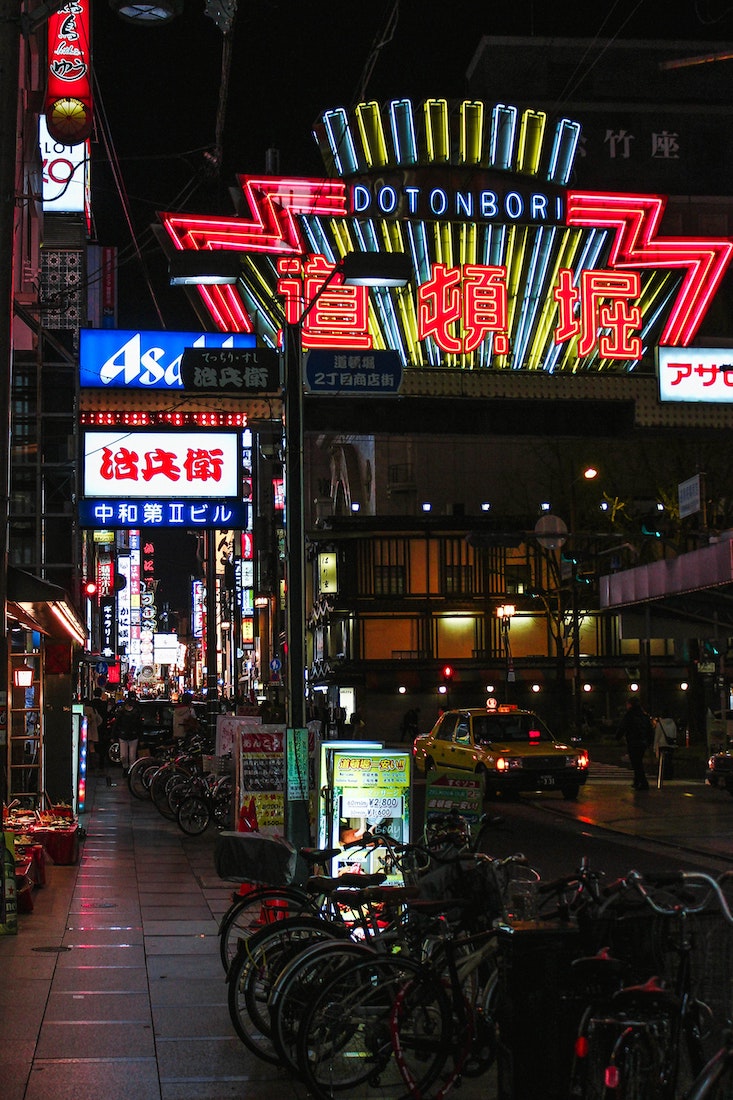
Dotonbori, Osaka
This hugely famous street in Osaka is known as ‘street food paradise’. It runs along the banks of the Dōtonbori canal from Dōtonboribashi Bridge to Nipponbashi Bridge in the Namba district. You’ll find a huge amount of different street food dishes to try – many of which involve seafood which Osaka is famous for. As we mentioned above, one of Osaka’s most famous dishes is Takoyaki – Diced octopus encased in a light batter and rolled into a ball – so be sure to try that. Dotonbori is also well known for its yakitori (grilled meat on a skewer). You can reach Dotonbori using the JRailPass by travelling to JR Namba Station from Shin-Osaka Station on the Tokaido-Sanyo line to Osaka Station. From there, take the Osaka Loop line to Imamiya Station. It’s then one stop to JR Namba.
Nishiki Market, Kyoto
This historic market is hundreds of years old and features a huge variety of savoury and sweet street foods to try. Also check out the market at Fushimi Inari Shrine, which is famous for its Yatai food stalls. Try Kyoto’s Tsukemono (Japanese pickles) or Taiyaki – a very popular and iconic Japanese sweet treat in the shape of a fish that can be filled with everything from red bean paste to chocolate and custard. You’ll find Nishiki Market within five minutes of Shijo Station on the Karasuma Subway Line or Karasuma or Kawaramachi Stations on the Hankyu Line.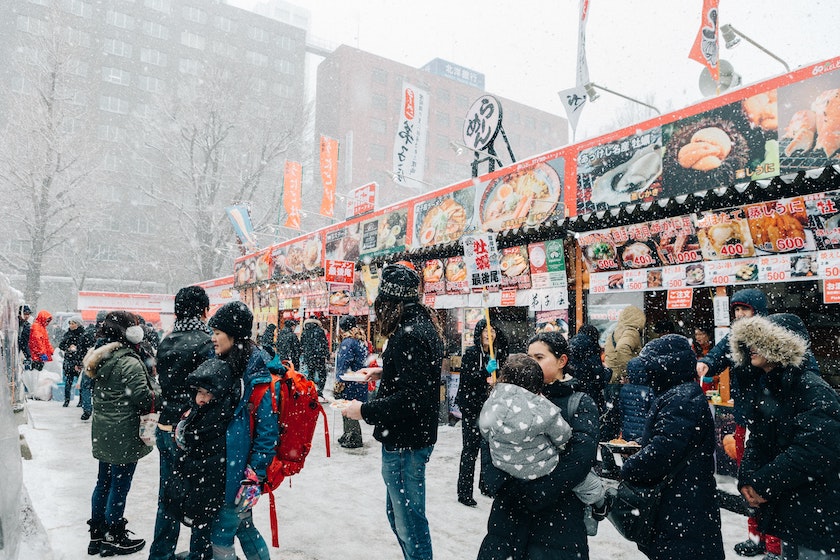
Sapporo, Hokkaido
As well as being famous for Tomorokoshi, Hokkaido – Japan’s northernmost island – has much to offer street food lovers, including a wide range of winter dishes associated with its colder climate and plentiful seafood especially crab, salmon, shrimp and sea urchin. It’s also home to the Hokkaido Winter Food Market, Sapporo Wholesale Market (amazing for seafood), and the famous Sapporo Snow Festival, which features plentiful Yatai street food vendors and stalls. And if you’re a fan of ramen, it’s rated as one of the top places to go. Ganso Sapporo Yokocho is regarded by many as the ‘original ramen alley’ and was visited by the late American chef Anthony Bourdain who braved the snow to eat at the famous Aji No Karyu restaurant. You can follow in the legendary chef’s footsteps by visiting 3 Minami 5-Jo Nishi, Chuo, Sapporo 064-0805, Hokkaido. To reach Sapporo from Tokyo using your Japan Rail Pass, take the JR Tohoku/Hokkaido Shinkansen from Tokyo to Shin-Hakodate-Hokuto and transfer to the Hokuto limited express to Sapporo.
Bonus Tips To Get The Most Out of Your Japanese Street Food Holiday
- When it comes to enjoying Japanese food, you may feel daunted by traditions, customs and etiquette. Don’t be! There’s nothing to be worried about and we have also put together this helpful guide to ensure you’re in the know before you go. Just read our Guide to Japanese Table Manners.
- Japan’s Street Food is amazing as we’ve discovered above, but every now and then it’s nice to have a fine dining experience too. Thankfully, Japan has one of the highest concentration of Michelin-starred restaurants anywhere in the world. Find out more in our list of Japan’s Best Michelin-Starred Restaurants.
- There’s also another very famous style of Japanese restaurant that we recommend everyone tries during a visit to Japan and that’s an Izakaya – a kind of Japanese gastropub where alcohol is just as important as food to the experience. Find out Why You Should Visit An Izakaya Restaurant by reading our guide.
- You know what foods you want to try, but what about drinks? Japan is of course famous for Sake (rice wine), but it’s also become a world-leader in whiskey and has a thriving craft beer industry. Discover your favourite tipple in Japan for Whisky Lovers and Kanpai! A Craft Beer Tour of Japan.
- Remember that if you’re travelling around inner cities on your street food adventure, you may want to consider a prepaid travel card such as an ICOCA, PASMO or Suica card as well as your Japan Rail Pass.




